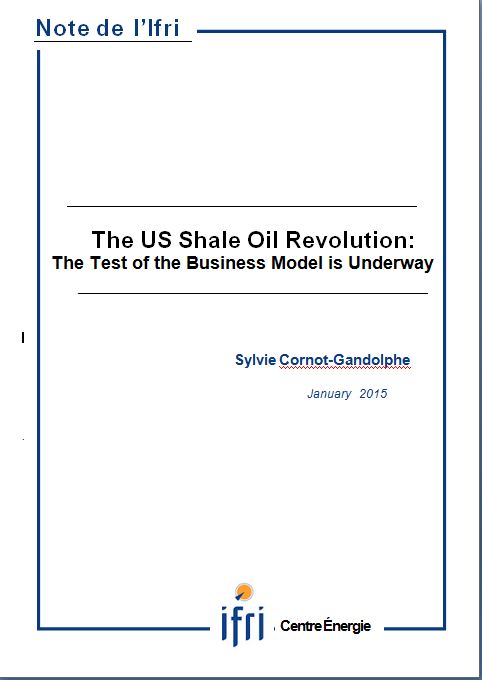The US Shale Oil Revolution: The Test of the Business Model is Underway

Since 2010, the United States has been undergoing a second shale revolution with the very rapid development of Light Tight Oil (LTO) or shale oil, following the revolution in shale gas. This development has allowed the production of oil and liquids to increase, so that the US is the world’s largest producer today, ahead of Saudi Arabia and Russia.
The production of LTO accounts for 55% of US crude oil output now, and has enabled the country to reduce its oil imports and expand its exports of oil products. This has important ramifications for the world oil market, traded oil flows and more recently the oil price.
As with shale gas, this oil production has a key impact on the US economy, especially on its trade balance, but also its security of supplies. It has allowed the country to cut its dependence on oil imports, which fell from 60% of consumption in 2005 to 27% in 2014. The significant industrial consequences for the US refining sector of this development also need to be noted, as it now has important margins, thanks to the price differential between Brent and WTI.
The fall in the price of oil, by 50% for the WTI between June 2014 and the beginning of January 2015, raises significant uncertainties concerning the ability of American producers to pursue further investments needed to sustain the shale oil revolution. As operating costs (OPEX) to produce LTO are limited, production at existing wells is not really called into question. But, LTO output is characterized by very rapid declines in initial production per well (between 60% and 90% in the first year). Therefore, sustained investment in new wells is necessary to maintain and/or increase output. Such rapid output decline means that projects are very strongly dependent on the price of oil in their first year of operation. This contrasts with conventional oil production whose economics spans much longer time periods. Accordingly, there are fears that lower oil prices will lead to cuts in investment in shale oil and hence a fall in production.
Breakeven prices provide information about the minimum prices needed for drilling projects to be profitable. Yet their analysis needs to be qualified. The cost of producing LTO is a determining factor, but it is practically specific to each individual well, given the greatly diverging geological properties of each formation, and even within a same play between “sweet spots” and wells at the periphery. It seems that the three main formations currently being exploited (Eagle Ford, Bakken and the Permian basin), which account for the majority of current output, have sweet spots for which the breakeven price is relatively low. This is reinforced if land acquisition costs and infrastructural costs are taken as stranded (so-called “mid-cycle” costs”). It therefore seems likely that drilling activities will move towards the sweet spots in these basins, and this has been confirmed by announcements made by operators, as well as the distribution of the fall in drilling activity by shale plays/states, observed since December 2014...

Available in:
Regions and themes
ISBN / ISSN
Share
Download the full analysis
This page contains only a summary of our work. If you would like to have access to all the information from our research on the subject, you can download the full version in PDF format.
The US Shale Oil Revolution: The Test of the Business Model is Underway
Related centers and programs
Discover our other research centers and programsFind out more
Discover all our analysesDonald Trump v. the States: the Case of New York
While the disruptive policies of the second Trump administration are being implemented at the federal level and on the international stage, they are also being felt in the federal states and major cities across the country. In the spring of 2025, several cases involving the state and city of New York demonstrate that the president’s attacks on environmental protection, the separation of powers, freedom of speech, etc., are also being carried out at the local level.
How the US under Trump Became a Strategic and Ideological Adversary of Europe
The Europeans' worst security nightmare seems to be coming true: on Tuesday, February 18, 2025, U.S. Secretary of State Marco Rubio and Russian Foreign Minister Sergey Lavrov met in Saudi Arabia to initiate the normalization of relations between their two countries. The meeting also aimed to set up peace negotiations for Ukraine. However, despite having the potential to affect the entire continent, the discussions took place without the Europeans or the Ukrainians being present.
Will Trumpian Authoritarianism Lead to a Constitutional Crisis?
Since his return to the White House on January 20, 2025, President Donald Trump has signed around sixty executive orders to implement his political agenda. Numerous other measures have also been introduced by the White House and the new Department of Government Efficiency (DOGE) as part of these orders.
Trump’s Second Term: Laying the Groundwork for a New Trade War
In a statement released on February 1, 2025, President Trump announced the implementation of a 10% tariff on Chinese goods and a 25% tariff on imports from Canada and Mexico. While the former took effect via executive order on February 4, the latter were granted a 30-day reprieve. Sanctions targeting European Union (EU) products are said to be imminent.










